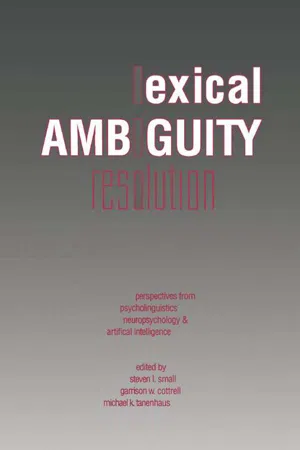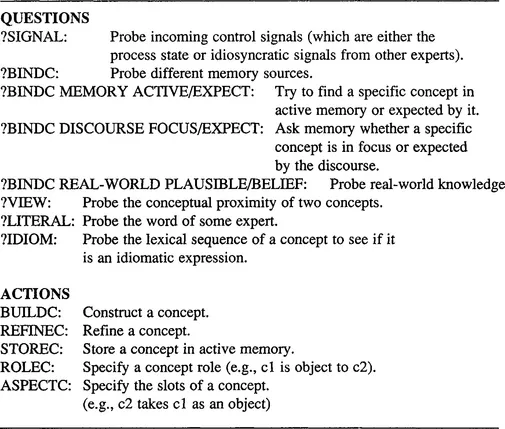2.1 General Principles
When we look at the words of a natural language (by skimming through a dictionary, or by introspection), we find that they are objects with a very rich and highly idiosyncratic content. Some help tie other words together (e.g., “a,” “the,” “in”), while others display a great number of different meanings (e.g., “deep,” “throw,” “pit”), from among which the human being is capable of picking the contextually appropriate one during comprehension.
A large number of existing parsing systems ignore this richness of individual words and the entirety of the sense selection problem. They advocate instead an approach that captures generalities about language in syntactic and/or semantic rules, treating the words as tokens that simply participate in comprehension by virtue of their inclusion in these rules (see [Rieger and Small, 1981]).
The apparent incompatibility of the sense selection problem and the rule-based approaches led to a radically different model organization. Instead of having a number of components (e.g., morphological, syntactic, semantic), consisting of static rule structures spanning sentence constituents or complete sentences, with some central interpreter taking care of the application of these rules to the input, the words themselves are considered as active agents, or word experts. They trigger processes that idiosyncratically control the whole parsing process. This process involves continuous interaction of a word with a number of knowledge sources in memory: the words in its immediate context, the concepts processed so far or expected locally, knowledge of the overall process state, knowledge of the discourse, and real-world knowledge. These knowledge sources are not invoked uniformly by a general interpreter, but are accessible at all times by the word expert processes throughout the overall process of sense discrimination. They help the experts to eventually agree on a context-specific semantic interpretation of a fragment of text. This overall parsing process makes crucial use of word-based expectations guiding the word experts in their sense discrimination.
In summary, word expert parsing is seen as a data-driven (word-by-word), expectation-based, highly interactive process coordinated by the individual words that are viewed as active knowledge sources (word experts). We will now take a closer look at matters of representation and implementation that turn these principles into a working program.
2.2 Representation
Informally, word experts can be viewed as sense discrimination networks consisting of nodes of context-probing questions and arcs corresponding to the range of possible answers. Each of the leaves of the network represents a specific contextual meaning of the word in question reached after network traversal during sentence processing. Figure 1.1 shows such an informal network for the highly ambiguous word “deep.” The left half of the net represents its adjectival usages ((1) through (4)), the right half its nominal ones ((5) through (7)). Meaning (1) would be arrived at in a context like “The deep philosopher likes Levinas,” (2) in a context like “He throws the ring into the deep pit”; meaning (5) would be chosen in the context “The giant squid still lives in the deep,” etc. for the other usages.
Figure 1.1 A sense discrimination network
These nets form the basis for the design and development of word experts, but have to be translated into a formal declarative representation used procedurally by the WEP process. Such a representation is a graph composed of designated subgraphs without cycles. Each subgraph (an “entry point”) consists of question nodes that probe the multiple knowledge sources mentioned above and action nodes that build and refine concepts, keep track of their lexical sequences, etc. These questions and actions constitute the formal representation language for word experts. We will not give a full description of the syntax and semantics of the word expert representation language here, but briefly mention the most important questions and actions that deal specifically with sense discrimination (excluding bookkeeping actions that keep track of lexical sequences, and internal expert control actions). The actions that deal with expert interaction are discussed in Section 2.3, the subsection about implementation. The Appendix contains an example word expert (the expert for “deep” that implements part of the network of Figure 1.1). A full description can be found in [Small, 1980], and partial descriptions in [Small and Rieger, 1982], [Small and Lucas, 1983], and [Adriaens, 1986b]. Figure 1.2 shows the questions and actions performing sense discrimination within the word experts.3
Figure 1.2 Sense discrimination questions and actions
The actions build concept structures as a side effect of the course of the overall parsing process. In WEP, these structures have received much less attention than the processing issues (how to control the expert interactions). Hence, not much will be said about them here. Nouns build entity concepts, that are refined by their modifiers; verbs assign roles to the entities, deciding on the contextually appropriate caseframe (the ROLEC action and its counterpart ASPECTC—see also Section 3.4). The result is a kind of dependency structure linking together all the concepts built up during the process.
The questions deserve a little more attention, since they direct the sense disambiguation process. An example of the SIGNAL question can be found in the word expert for “deep” in the Appendix. In order to find out at what point it enters the process, “deep” probes its incoming signal (if it is entity-construction, “deep...


